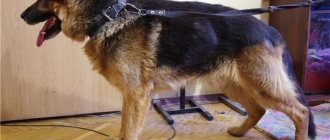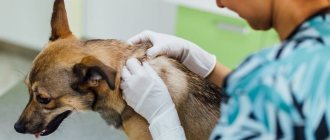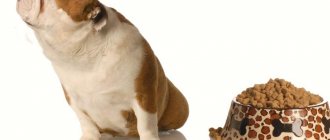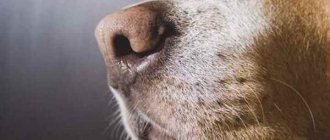Associated symptoms and behavior of the animal
Even small cracks in the pads of the paws can cause serious discomfort to the dog.
This manifests itself in the following signs:
- afraid to step on paws;
- advances, but limps;
- Constantly licks his pads.
There are cases where the cracks were so deep that the pet whined with every movement or even refused to stand on its feet again.
Along with this symptom, the animal’s appetite or activity usually does not disappear until the inflammatory process begins. If the wound does not heal for a long time, then there is a high risk of infection. This causes redness and swelling of the paw; in severe cases, blood and pus may ooze from the cracks.
Treatment of wounded paws if the dog is limping
If the animal, in addition to visible cracking of the paw crumb, also has lameness, self-medication is unacceptable. Indications for contacting the clinic are also swelling, redness, pain on palpation, redness of the pads, bleeding from the paw.
The dog should be shown to a veterinarian to rule out more serious problems - penetration of a foreign object into the deep layers of the skin, development of erosive dermatitis, purulent inflammation of soft tissues.
After identifying the problem, the veterinarian will prescribe treatment. Severe injuries to the soft tissues of the paws require surgical cleaning of the wounds from foreign objects, dirt, and dried blood. Antiseptic solutions are used to treat paw crumbs. In case of deep damage, the wound is additionally sprinkled with streptocide and sutured.
Anti-inflammatory ointments - Tetracycline, Levomycetin, Streptomycin - will help soften and relieve inflammation. If the wound is complicated by a purulent infection, Ichthyol ointment and Vishnevsky liniment are applied topically to the animal. In some cases, a veterinarian may prescribe a course of antibacterial therapy to prevent the spread of purulent inflammation to healthy tissue.
Multivitamin and mineral supplements in food help improve the condition of rough skin, reduce inflammation and accelerate tissue regeneration. In order to eliminate the deficiency of zinc and selenium in the diet, the animal is prescribed their preparations. The dose of microelements will be determined by a veterinarian. Complex vitamin formulations or adding pharmaceutical preparations to food in the dose recommended by the attending physician will help eliminate the deficiency of vitamins A and E.
A good therapeutic effect is obtained by enriching the dog’s diet with bone and meat meal, adding Tetravit and fish oil, Biotin.
To learn how to apply wax to your dog's paws, watch this video:
Common Causes
Each case is individual, so a visual examination of the animal and collection of complaints from the owner’s words are of great importance in determining the cause. Only then will it be possible to exclude or confirm the following reasons.
Weather
In winter, dogs often get corroded pads on their paws due to the “chemicals” that are sprinkled on the roads. Even ordinary salt, which in many regions is still sprinkled on roads against ice, can cause serious harm to a pet’s paws.
During this period, the animal needs special care - after a walk, thoroughly wash its feet with warm running water. At the initial stage, a white coating appears on the pads, under which small cracks may be hidden.
To prevent this phenomenon, it is recommended to treat the pads with special wax in winter, which is sold in every veterinary pharmacy.
Poor nutrition
The most common cause of deep cracks in the paw pads of dogs at any time of the year. Breeds with allergies are at risk (Shar Peis, Mastiffs, Pugs, English and French Bulldogs).
Here you need to exclude two options - an excess of protein in the diet or a lack of it. The problem is solved by selecting food/products based on the pet’s accompanying symptoms and behavior. Much attention is paid to coat color and shedding.
Injuries
A common occurrence among hunting breeds and dogs that often walk in the forest. You can get hurt on needles, sharp branches and even some grass.
Such wounds appear on the pads in the form of small cracks, which you notice only when the pet begins to limp or lick the affected area. Only deep cuts are dangerous; small ones heal on their own within 1-2 days.
During this period, it is better to give the animal a rest, reducing the walking time by at least 2 times. For any cuts, it is recommended to treat the area with chlorhexidine solution.
We also do not forget that age also plays a big role, so problems with paw pads are diagnosed in older dogs much more often than in young, active individuals.
Causes of cracks
First of all, you need to understand that the pads are a kind of natural shock absorbers, the role of which is to reduce the load on the skeleton. This is especially true for representatives of service breeds who have to move a lot and run on hard surfaces.
It also happens that owners, trying to introduce their pet to active exercise, begin to intensively walk and train them. Such experiments lead to the fact that after jogging, the pads on the paws quickly become covered with cracks, causing considerable discomfort, even lameness, and pain.
Considerable damage to paws is caused by hot asphalt, ice, snow, as well as reagents used to treat roads during the cold season. Snow crystals, sticking to the pads, injure the paws, “chemicals” penetrate into the cuts, the skin on these parts of the body becomes dry, rough, often red, and then cracks appear on it.
Some dogs, as a rule, are representatives of decorative breeds, whose pads are naturally so soft and gentle that the use of special shoes during walks becomes not a whim, not a tribute to fashion, but a stern necessity, protection from all types of chemicals.
In addition, the pads react very sensitively to changes in nutrition, especially to a lack of components such as zinc and selenium. If they are absent from the food, then cracks on the dog’s paw pads will not be long in coming.
Thus, the reasons contributing to the appearance of cracks include hard road surfaces, climatic conditions and poor care of the animal (improper feeding, lack of water and, as a result, dehydration). If these factors are eliminated, the paws may well become overgrown spontaneously.
Cracks on a dog's paws photo
Maintenance and care of paw pads
Make it a habit to check your dog's paw pads regularly. Gently spread the toes and inspect the sides of the paw pads and toes for damage or foreign objects (such as burrs, pebbles, or splinters). This is also a good time to check for swelling or discoloration. See if your dog shows any signs of pain when examining his foot.
Avoid walking your dog on hot asphalt! You can easily test whether the ground is too hot for your dog by placing the back of your hand on the pavement and holding it there for 7 seconds. If you're too hot, your dog won't be able to walk on it!
Just one detail in Vertinskaya’s outfit helped Korenev’s wife guess about the betrayal
“Fought” for every scene. “Kalina Krasnaya”, which ruined Shukshin’s health
Rosy baguette, cheese and poached egg: preparing a delicious and satisfying breakfast for the whole family
Winter can also be brutal on your dog's paw pads (snow, ice and salt). Even if the ice has melted, this is not a signal that your dog is now safe. Many factors can cause the paw pads to dry out, crack, or even burn, and can also be toxic if the dog ingests them by licking them off their paws. Be sure to wash your paws after any, even short, walk outside.
How can you treat cracks?
Cover the pads only for deep cuts. Dogs successfully lick small cracks on their own!
It is best to show your pet to a veterinarian in order to determine for sure the nature of the appearance of cracks on his paw pads.
If this is not possible or you want to immediately help your animal, then you can use the following means:
- Ointment "Zorka" , which is sold only in veterinary pharmacies. It is considered the most effective healing agent used for cuts, cracks and deep wounds on the pads of the paws. It can also be used as a preventive measure in winter after each walk.
- For deep cuts, it is recommended to thoroughly rinse the affected area with warm, running water, wipe dry and treat with chlorhexidine solution. Next, a gauze bandage soaked in levomekol is applied to this place. It must be secured carefully so that the animal cannot remove it. Change the bandage 2 times a day after each walk until complete healing.
- Special wax . An excellent tool to prevent cracks in the future. It is used in winter, when there is a high probability of the pads being corroded by saline solutions and de-icing chemicals. It is applied in a thick layer, which allows you to form a water-repellent film around the pad. After each walk, the wax is thoroughly washed, and the paws are treated with baby cream.
Some owners find a way out by buying/sewing special shoes for their pet, but, unfortunately, not every dog wants to walk in such uniform.
Clean and healthy dog paws are the main component of a full and active life for your pet. In this regard, carefully monitor their condition, do not allow diseases to persist, and do not make life difficult for your pet. In principle, dogs' paws can become dry for a large number of reasons, for example, insufficient vitamin content in food, climatic conditions, or wear and tear with age.
You can independently take simple measures to treat and prevent dry paws in dogs in the future.
Due to the fact that the current level of health and hereditary predisposition of all dogs is different, it would be best to consult your veterinarian first. Specialists can also help not only in determining the causes of increased dryness of a pet’s paws, but also in treating infected cracks on the pads of a dog’s paws. Household chemicals can cause increased dryness of paws in dogs. Keep an eye on your dog's lifestyle and eliminate harmful influences that could worsen its condition. Try changing the floor cleaner, furniture cleaner, washing powders you use to wash your dog’s clothes, and also find a product with a low pH to clean paws at the end of a walk, etc. Use methods to prevent excessive dryness of your dog’s paws due to weather conditions by treating them with some kind of moisturizer at the beginning of the walk.
Wash your dogs paws for road hazards and wipe them down with a protectant after washing. Change routes, do not walk with your dog on roads that are sprinkled with salt or chemicals. Using homemade dog booties can prevent painful dryness of your dog's paws. Place cotton pads with nourishing cream or some natural extract on them (we especially recommend shea butter). Remove all potential sources of skin irritants and allergens. Use dog socks to protect paws in bad weather. Do not take your dog for a walk with cracked paw pads on hard or very uneven surfaces.
Make sure your pet's food contains the required portion of vitamin E. It is even better to purchase it in liquid form and lightly lubricate the cracks on your pet's paws with it. Another reason for dry and cracked paws may be a lack of zinc in the body.
In turn, cracks on the pads may be a specific type of dermatitis associated with biotin deficiency. Biotin (or vitamin H) is supplied in sufficient quantities by the intestinal microflora. An insufficient amount of biotin can occur either due to any metabolic failures, or due to problems in the functioning of the microflora. The liver of many animals is very rich in biotin, therefore, adding about 100 g of raw thawed beef liver to the dog’s diet should help it. At the same time, treat it with microflora agents (bactisubtil, lactobifadol, bifidumbacterin, etc.)
Make sure your dog has clean water in his bowl at all times.
Various special moisturizing preparations are produced for dogs suffering from dry paws.
One of the recipes for a protective mixture: 40% pure lanolin; 40% internal fat; 20% beeswax. We melt each of these components and mix them together, then pour them into a jar and lubricate the paws before starting the walk. First, moisten it well with Show Foot-professional anti-slip spray (it is used to better secure a dog in a show that walks on a slippery or parquet floor) - this leaves a protective shell. Before going outside, the dog is additionally recommended to lubricate its paws with film-forming aerosols - Chronicin or Kubatol. It is excellent to treat with a special silicone cream (it is available in perfume stores - usually to protect your hands). But! Before lubricating the paws, you need to remove excess hair from between the dog’s toes. Remove the fur very carefully, so as not to touch the paw or damage the membranes, use small, sharp scissors, always with DULL ends.
During the process of contamination, microbes remain on the dog's fur, after which mycoses are likely to develop. When there is a lot of fur, snow will stick to it; during a walk, the pet will sit down and clean its paws all the time.
Today in the retail chain you can find a variety of shoes and boots for animals. Without which you simply cannot do in case of a paw injury (the paw will not get wet or dirty). In retail you can find special kits only for sled dogs. They consist of four boots (for each foot), they themselves are high and are held at 3 points, secured with adhesive tape near the foot.
At the end of the walk, you should wash your paws, wipe them dry and carefully lubricate them well with cream or lotion. You can use Zorka ointment.
To prevent the dog from licking off all the cream with its tongue, put small socks on its paws. Such measures will protect your animals’ paws from cracks and wounds. Before going to bed, the paws are thoroughly treated with homeopathic cream “Graphite” (this drug is used in case of cracks in the paws).
But we must first caution. The ointment is black and very greasy (base is Vaseline). When using it, it wouldn’t hurt to put a plastic bag on top. This should be done to ensure greater penetration of the ointment into the cracks of the dog’s paws (the “compress” effect); the bags on top should be bandaged and secured well. Cream gel against calluses (“Ambulance”) also works well. The ointment contains: wax, olive oil, salicylic acid, extracts: celandine, aloe, nettle, garlic, potato, glycerin, vitamin A, collagen).
You can treat your dog’s paws with “Rescuer” or “Keeper” balms, “Solcoseryl” or “Actovegin” ointment-cream.
So, health to you and your wonderful pets!
0
Preventing problems
Advice and recommendations from experienced dog breeders and veterinary specialists will help prevent the occurrence of a problem that limits the free and painless movement of your pet:
- Walking your four-legged friend should be done in a specially designated area, trying to avoid asphalt, concrete surfaces, and hard grass. Periodically, the walking area must be inspected and foreign objects removed from the site to avoid injury to the animals.
- In winter, when deicing agents are widely used, it is necessary to wear special protective shoes on the dog’s limbs. Your pet should be taught to wear boots from an early age. It is necessary, first of all, for owners of decorative and miniature breeds to pay attention to this issue.
- Before a winter walk, special wax, for example, “Let’s go for a walk,” will help protect the paw crumbs from cracking. The product will protect delicate tissue from the effects of adverse external factors.
- If the pet flatly refuses to walk in winter in protective shoes, as well as during walking in the summer, then after going outside the paws must be washed with pet shampoo. Then the soft tissue of the pads should be treated with an emollient cream, for example, “Children’s” or Vaseline.
- When washing indoor floors, do not use aggressive detergents, which can irritate the delicate skin of the pads.
- Trim your dog's nails in a timely manner, since when they grow excessively, soft tissue injuries occur more often.
- The diet of a pet predisposed to the problem of cracking of paw crumbs should be enriched with vitamins A and E, and the content of zinc and selenium in it should be monitored in recommended quantities. If necessary, add vitamin and mineral complexes to the food recommended by a veterinarian.
We recommend reading about a broken paw in a dog. From the article you will learn about the causes and types of fractures, symptoms of fractures of the front and hind legs, first aid for a pet, diagnosis and treatment.
Read more about rib fractures in dogs here.
Cracks in the paws of dogs occur under the influence of a whole complex of factors - an unfavorable external environment, predisposition and, as a result, a deficiency of vitamins and minerals in the diet. The cracked skin should be treated with an antiseptic and then lubricated with a softening anti-inflammatory cream. If lameness is detected in a pet, the owner should not self-medicate, but seek qualified help.
Pododermatitis in dogs
When taking a dog into your home, you need to be prepared for a lot of hassle, both pleasant and not so pleasant.
Like people, animals are susceptible to many diseases, but unlike a person who can clearly describe how they are feeling, a dog will suffer in silence. Pododermatitis is a fairly common disease characterized by an inflammatory process in the interdigital space and on the pads of a dog’s paws. Severe pain that occurs when moving forces the animal to move less. An attentive and responsible owner will easily identify changes in his dog's behavior and immediately take him to the veterinarian.
Causes of the disease
Pododermatitis in dogs is always a secondary disease that develops against the background of some underlying disease. Veterinary experts believe that pododermatitis occurs in animals with weak immunity. Before starting treatment for dermatitis, it is important to first find out the true cause of its development, otherwise the therapy will be ineffective.
The main causes of pododermatitis are:
- fungal skin infections;
- disturbances in the hormonal system, endocrine diseases;
- the presence of parasites in the animal’s body (fleas, ticks, helminths);
- allergic dermatitis (contact or food);
- cancerous tumors;
- bacterial infections caused by staphylococcus, Proteus, Pseudomonas aeruginosa, etc.;
- autoimmune diseases (vasculitis, systemic lupus erythematosus);
- various injuries and cracks on the pads of the paws and fingers;
- getting glass, sharp objects and thorns under the skin of the paws;
- irritating factor (asphalt pavement, reagents added when ice occurs in winter).
Some dog breeds (Labradors, German Shepherds, Dachshunds and Pekingese) are particularly susceptible to pododermatitis. It is in these breeds that the disease is diagnosed more often than in other animals.
Symptoms of pododermatitis in dogs
Depending on the cause that provoked pododermatitis, the symptoms of the disease will vary significantly, but there are also general signs of the disease that are characteristic of all forms of pododermatitis:
- The dog's limbs swell and become swollen.
- The animal begins to limp, and if the disease is particularly severe, the dog may completely lose motor function.
- The pet constantly licks its paws and looks restless.
- In the space between the toes and on the pads of the paws, the skin, as a rule, becomes very red, inflamed, and the animal feels sore. The formation of fistulas, wounds, and abscesses often occurs.
The development of pododermatitis due to fungus or bacterial microflora is accompanied by redness, inflammation and swelling of the areas between the toes and paw pads. Often ulcers and ulcers form on the affected areas. Local body temperature rises.
Allergies that appear after contact with various reagents cause symptoms of pododermatitis such as:
- redness and inflammation of the skin;
- very severe itching on the paws, fingers can hardly be distinguished due to scratching (the skin is so torn);
- baldness of the paws (hair rapidly thins and falls out).
General allergies have similar symptoms to contact allergies, but the affected areas are concentrated not only on the dog’s limbs, but also on other parts of the animal’s body (the muzzle most often suffers).
Pododermatitis, which appears against the background of autoimmune diseases, is more difficult to diagnose than all other forms of the disease. To identify this type of dermatitis, you will need to undergo many tests. The symptoms are similar to allergic pododermatitis, but there are still some differences: the skin of the paw pads becomes very thick and darkens.
The endocrine factor of pododermatitis is manifested by severe redness and inflammation of the skin in the interdigital space.
Pododermatitis of an oncological nature is considered the most dangerous and is characterized by the appearance of various neoplasms, growths and ulcers on the pet’s body.
Find out also about other skin diseases in dogs >>>
Diagnostics
If signs of pododermatitis appear, the animal should be taken to a veterinarian as soon as possible. The doctor will definitely ask the dog owner about such features as:
- seasonality of the disease;
- contact of the four-legged pet with other relatives;
- introducing new products into the animal’s diet;
- the owner's attempts to cure the disease on his own.
To make an accurate diagnosis, the following methods are used:
- general and biochemical blood test;
- Analysis of urine;
- allergen tests;
- cytology;
- biopsy;
- antimicrobial susceptibility test.
Differential diagnosis excludes the presence of diseases such as fungal skin infection and demodicosis.
Treatment of pododermatitis in dogs
Treatment methods directly depend on the cause of the disease. There are no general treatment tactics; treatment is selected individually for each sick animal.
The following methods are mainly prescribed:
- use of antimicrobial drugs;
- use of antifungal agents;
- antihistamine therapy;
- treating affected skin with antiseptics;
- lifelong use of certain medications;
- special diet;
- surgical intervention.
The veterinarian prescribes treatment depending on the type of pododermatitis identified in the sick dog:
- The aseptic appearance is characterized by persistent inflammation and severe pain. Tissue damage is usually not accompanied by a purulent process. Treatment at home is aimed at daily treatment of wounds with antiseptic agents.
- The purulent form of pododermatitis occurs with the addition of a purulent infection. The symptoms of purulent dermatitis are so vivid (severe pain, high temperature) that there is no doubt about the diagnosis. This form of the disease should be treated only with antimicrobial drugs. In particularly severe cases, surgery is prescribed to remove the affected tissue.
Treatment of pododermatitis is very long, but even after a positive outcome of therapy, relapses of the disease are often observed (especially in winter and autumn).
Prevention
To prevent the development of the disease, you must follow simple rules for caring for your pet:
- Keep the dog's area clean (regularly shake out and clean the dog bed).
- Keep your animal's feeding bowls clean.
- Trim your dog's nails in a timely manner and prevent them from growing too long.
- Trim the hair between the toes.
- Feed your dog only high-quality and balanced food.
- After visiting the street, wash the animal's paws.
- Treat your dog for parasites in a timely manner.
- Avoid contact between your pet and sick dogs.
When the first signs of pododermatitis appear, you need to contact a veterinarian as soon as possible, preventing the disease from progressing. It is impossible to stop the treatment prescribed by the doctor, even if the dog’s condition clearly improves; the course of therapy must be completed completely.
Dogs are very people-oriented and completely trust their owner. A caring owner, seeing that his pet is sick with pododermatitis, will not hope for independent healing of his four-legged pet, but will take the patient to the doctor in the very near future.
Source: https://zen.yandex.ru/media/ivethelp/pododermatit-u-sobak-5d07759ec7acc50d8af02332










